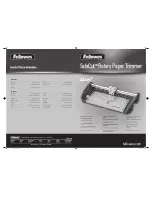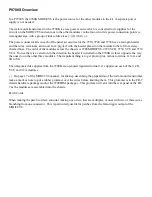
3-20
If all tests pass, the program will loop in Lamp
Test mode with all LEDs turned on until PAD is
pressed again. This permits a more thorough eval-
uation of lamp integrity than is possible during
the brief RUN Mode test.
When PAD is pressed again, the CAL Menu will
be displayed in the Coag Power window.
Optional load resistance selections set during the
previous CAL run will be restored from the
NOVRAM and displayed in the Cut Power win-
dow. The Menu selections are displayed in rotat-
ing fashion when the Coag Power control is
rotated, and the Options are similarly selected
when the Cut Power Control is rotated.
When the desired Menu and Option are selected,
they are entered when the PAD button is pressed.
In Monopolar Cal (C-C), the power controls
select the desired cal point while the unit is not
being activated, and make single-step increments
or decrements in the PA drive and the selected
NOVRAM cal value when the unit is activated.
Upon deactivation, the last cal value remains in
the NOVRAM location selected. Adjustments are
limited to +/-25% around the nominal stored in
Program ROM to prevent "calibrating around a
failure."
If a single point in a Cal Menu selection is adjust-
ed, then all other points in that selection are
flagged as uncalibrated. Those points are returned
to calibrated status when they are selected and the
unit is activated, whether or not they are adjust-
ed.
Exit from a Menu selection is achieved by press-
ing PAD again. Before returning to the Cal Menu
display, the firmware performs quality tests on the
stored cal point values. If a value is out of expect-
ed range, left uncalibrated or non-monotonic, a
HLP Code is displayed, but the program is not
terminated. Upon the next PAD press, the CAL
Menu is displayed, with the problematic Menu
selection now flashing. If the tests pass, the CAL
Menu will be returned to without a HLP code,
and the selection will not flash.
Diagnostic Modes do not return to the CAL
Menu. Once entered, exit is gained only via RST
or cycling power. Once a CAL Menu selection
which produces output power is entered, the
WDT Diagnostics (dI 2) Menu selection is no
longer available, since RLYENA has been set to
provide output, but also forcing the WDT to lock
up permanently if WDT-Q2 ever fails.
Pseudo Run Diagnostics (dI 1) is simply RUN
Mode with all fault detection processes bypassed.
It is useful for troubleshooting faults which will
otherwise disable the machine. It will also allow
the unit to be operated with all PA fuses
removed; this condition will result in HLP 5 in
RUN Mode.
3.6 USER INTERFACE
The Display PWB Assembly (A2), in conjunction
with the Control Panel (A1), is the user interface
to the unit for all inputs except hand and foot
controlled activation requests. Power settings,
mode requests, and return electrode alarm set
point are all entered via the front panel membrane
switches. The various indicators and displays sup-
ply machine operating status. These include
requested power, mode, return electrode resis-
tance, and alarms if they occur.
3.6.1 Displays
Refer to the Display Schematic Figure 5.5.
The MACHINE FAULT indicator is controlled
separately from the rest of the displays. It is hard-
wired to the WDT circuit and in the event of a
Watchdog Timer interrupt, this LED is illuminat-
ed when the signal WDTFL from J1-4 is high,
causing Q1 to turn on. Since this indicator is
hardware controlled, it illuminates in the event of
a machine failure even if the microprocessor can-
not process the Watch Dog Timer Interrupt.
The control of all other displays, power controls
and the control panel pushbuttons is performed
by the Keyboard/Display Interface, U1.
Multiplexing of the displays is implemented by
the outputs SL0 - SL2 counting in a binary fash-
ion which is decoded by U2. The outputs of the
decoder (U9), go low sequentially (/S0, /S1, /S2,
/S3, etc.) scanning each digit, discrete LED
group and bar group. The internal circuitry of U1
reads each digit data stored in internal RAM and
drives the segment output (B0 - B7) in sync with
the scan lines. Current is then supplied to the cor-
Summary of Contents for sabre 180
Page 1: ...Service Manual...
Page 6: ...This page intentionally left blank...
















































